C&S #30, a C-16 conversion
Posted by John Greenly on Jan 08, 2020; 4:45am
URL: http://c-sng-discussion-forum.254.s1.nabble.com/C-S-30-a-C-16-conversion-tp15055.html
Hi all,
I'm working on a project that might be of interest to those modeling the early C&S years. I'm gradually converting an HOn3 C-16 to model C&S #30, circa 1905. Most of the photos I know of of #30 are in Vol. VI of Grandt's Narrow Gauge Pictorial, on pages 78-81. The first two are from 1902 when the engine had the intertwined "columbine" lettering, had a single air tank on the boiler, and still had its short smokebox and McConnell stack. The other two photos, which have been published several times and are in the Salida Archive online (in great scans with maximum detail) are from 1910 when it worked on the Alma branch, as it apparently did for most of its C&S life. By then it had the modern lettering, the extended smokebox, and at that date the "diamond stack of 1910", and the second air tank had been added. I'm going for the short period in between that is pictured in the photo at Como when the engine was derailed. This has been attributed to several dates in different publications, but probably 1905-6 is right, I think-? Here's an enlargement of #30 in that photo:
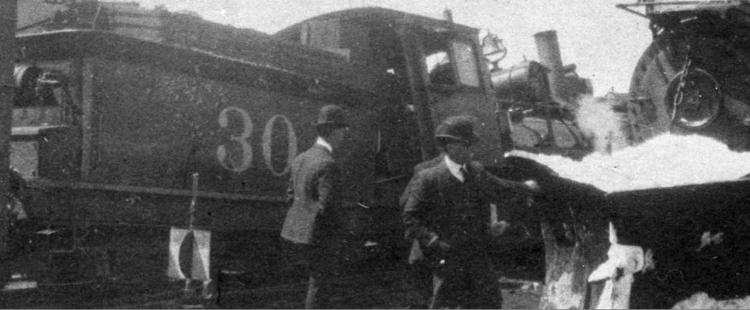
#30 then still had the single air tank, but the new stack (and, surely, the extended smokebox), and still had the Columbine lettering. I'm finding myself more and more interested in this time period, when so much was changing on engines, and a lot of the inherited rolling stock was still in service in varying states of dilapidation. Well, here's where I have gotten so far with my model:
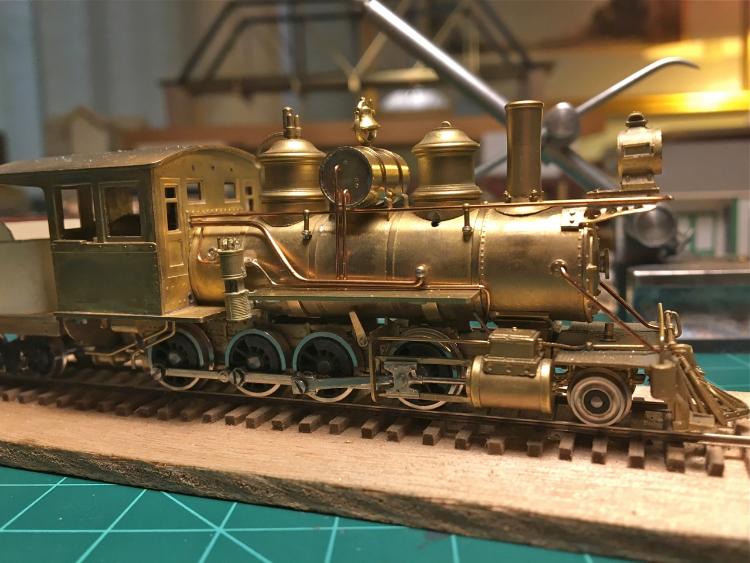
I started with an old Westside C-16 #278 from the mid-1970's. These are plentiful on Ebay, and you can still get a nice one for $200 if you're patient. I bought a nice one a while ago to detail using Kemtron C-16 parts given to me by my best old friend who 50 years ago introduced me to the Colorado narrow gauge roads. Baldwin built the C-16's and the engines that were originally DSP&P #s 190-197 to nearly identical basic dimensions. D&RG 278 was built in 1882, while DSP&P #190, which became C&S #30, was built in 1880. I got excited about making a #30, which was the only one of its class to last long enough to be called a B4A on the C&S, so I watched Ebay until I found another Westside C-16 in rather poor shape, but it did have what looked in the photos to be very neat soldering that would ease the disassembly and cleaning up for the conversion. And it was cheap! Here's what it looked like when I got it:
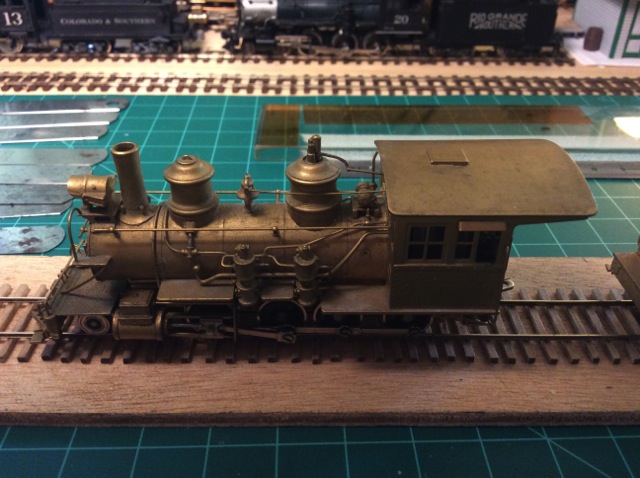
This one was very dirty and a bit sad, but these are nice little models. Their main shortcoming was that they had a huge open-frame motor sticking out of the cab:
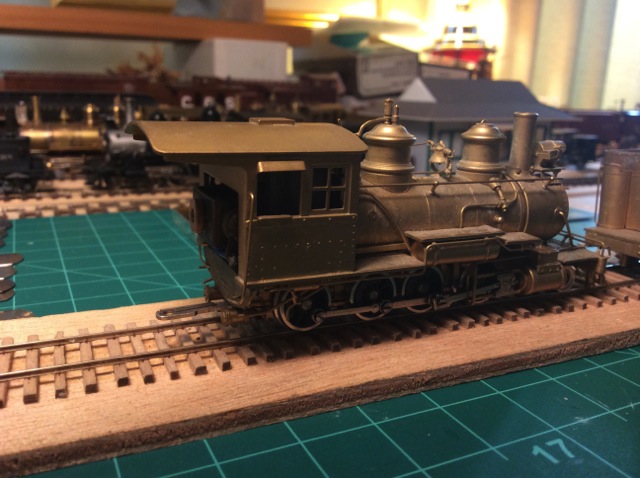
Here's what it looked like stripped of its Rio Grande hardware, and with the cab floor and windows modified to the new form:
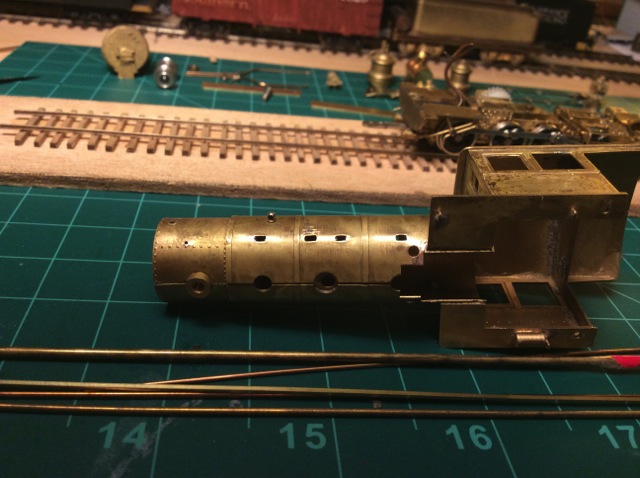
There were a lot of holes to fill. The round holes I filled with suitable size rod or wire, and the rectangular holes I filled with .030" square stock, cut with tapered ends so that it pressed in tight against the ends of the hole. This held it in place easily for soldering. The next photos show this process.
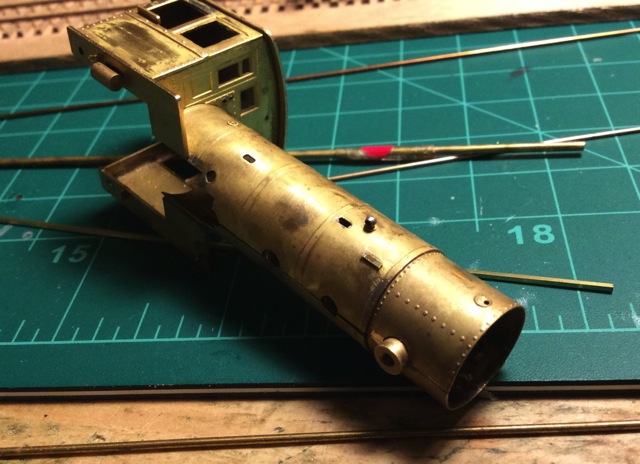
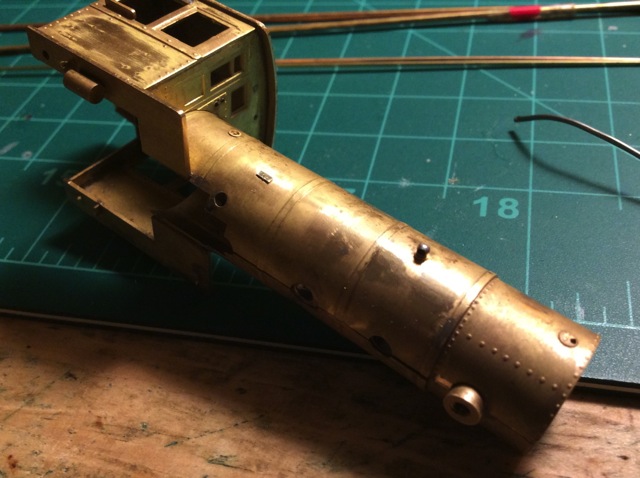
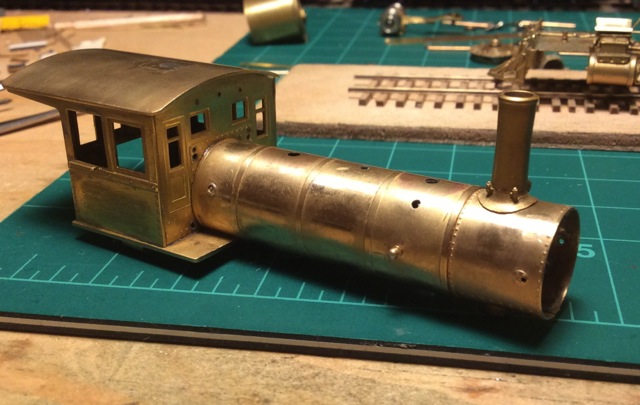
I had to move the washout plug on the engineer's side because it would have been behind the air pump. This probably looks like a lot of work but it actually went quickly, and it was a very fun evening watching the holes disappear as the jeweller's file shaved off the nubs. I didn't use any abrasives, to keep a nice smooth surface. I did use brass cleaner/polish to get the oxidation and dirt off before I started soldering.
Next it was time to start on its new life. There are unfortunately very few correct parts available in HO scale. I made the air tank and its mount (which was hard to get the right shape, took a couple of tries), and the most crucial part of the South Park identity, the headlight bracket. Here are a couple of closeups:
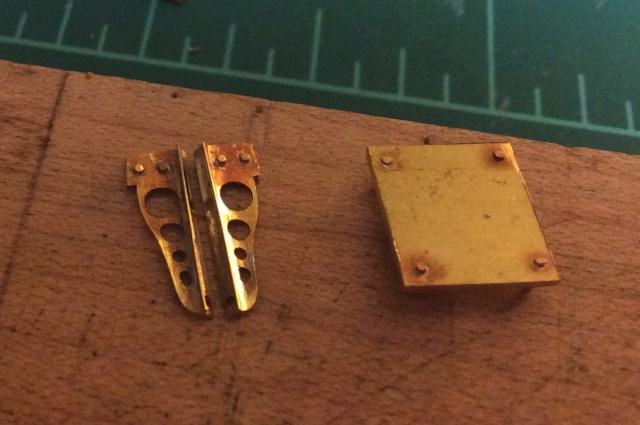
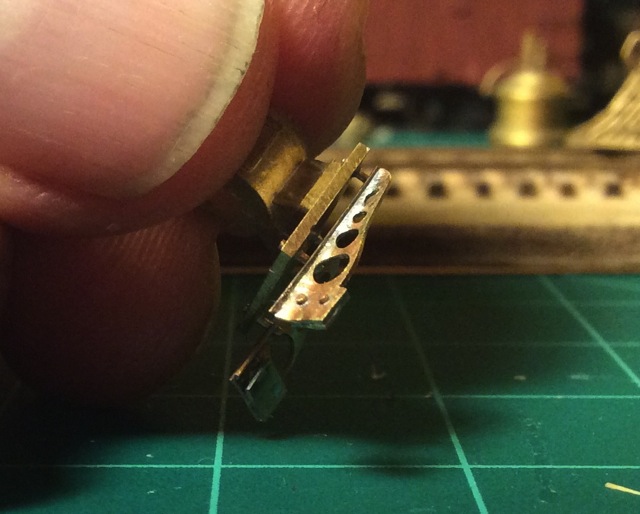
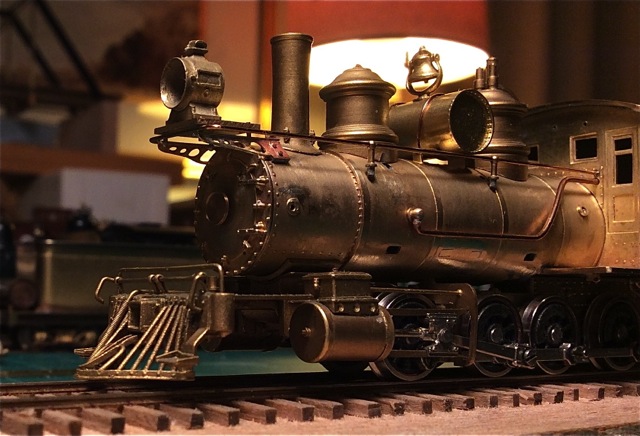
I had already found with the first C-16 that it was just exactly possible to fit the superb Faulhaber 1331 motor into the boiler-- if, and only if, all the inward projecting tabs and posts of the mounted parts were filed away inside. The original gearset is used, but the idler gear has to be moved to mate with the different worm position. I found an easy way to do this accurately without machining. If anyone is interested I could show how it works. The result is an amazing running engine that can start up almost imperceptibly and has way more than enough power for the available traction of this little HOn3 engine. It can pull a train along smoothly at a speed of one tie in 20 seconds. Incredible! This re-powering was quicker to do with #30 because I had removed from the boiler all the inward-projecting hardware. That saved an hour or so of awkward filing. This also allows me to have a backhead. I used one, and a nice cab back, from my donated collection of C-16 parts. The old Kemtron cab back fit perfectly on the Westside cab with about two swipes of a file:
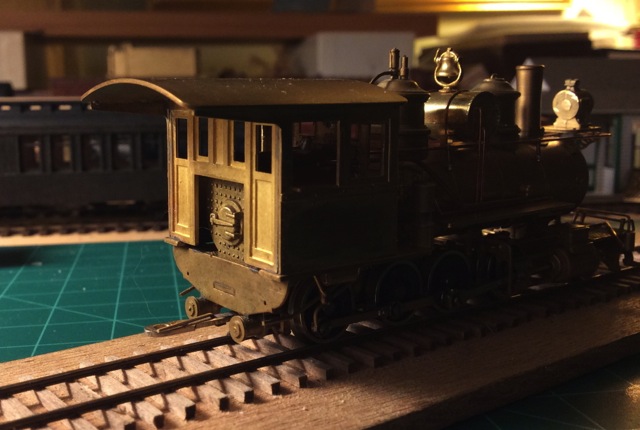
I'll redo the back of the cab floor and the frame support when I do other work on the frame later. There's a lot to do. I need to make a new stack, a new firebox front, a new pilot....
This brings me to a question. What should the pilot deck area be like on this engine? It's hard to see in the photos I have, but it looks like there was no decking between the cylinders and the pilot beam. Is that right? I need help with this. A second question: should this engine have a canvas-covered roof? I don't see any sign of a cab roof vent. Is there none? Also, please let me know if I've made mistakes in what I've done so far. The nice thing about brass construction is that it can always be changed! And, finally, I'd be extremely grateful to know of any other photos of #30.
Anyway, I'm enjoying this project greatly, and I think now my #30 has got the beginnings of a proper C&S identity. The comparison with what the D&RG did with their version (that one, #278, I'm making about as it was in the early 1920's) makes quite a contrast:
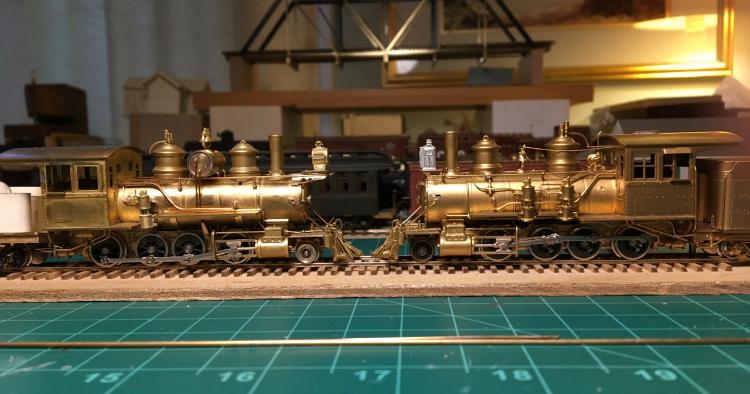
I think the C&S engine is better looking.
Cheers,
John
URL: http://c-sng-discussion-forum.254.s1.nabble.com/C-S-30-a-C-16-conversion-tp15055.html
Hi all,
I'm working on a project that might be of interest to those modeling the early C&S years. I'm gradually converting an HOn3 C-16 to model C&S #30, circa 1905. Most of the photos I know of of #30 are in Vol. VI of Grandt's Narrow Gauge Pictorial, on pages 78-81. The first two are from 1902 when the engine had the intertwined "columbine" lettering, had a single air tank on the boiler, and still had its short smokebox and McConnell stack. The other two photos, which have been published several times and are in the Salida Archive online (in great scans with maximum detail) are from 1910 when it worked on the Alma branch, as it apparently did for most of its C&S life. By then it had the modern lettering, the extended smokebox, and at that date the "diamond stack of 1910", and the second air tank had been added. I'm going for the short period in between that is pictured in the photo at Como when the engine was derailed. This has been attributed to several dates in different publications, but probably 1905-6 is right, I think-? Here's an enlargement of #30 in that photo:

#30 then still had the single air tank, but the new stack (and, surely, the extended smokebox), and still had the Columbine lettering. I'm finding myself more and more interested in this time period, when so much was changing on engines, and a lot of the inherited rolling stock was still in service in varying states of dilapidation. Well, here's where I have gotten so far with my model:

I started with an old Westside C-16 #278 from the mid-1970's. These are plentiful on Ebay, and you can still get a nice one for $200 if you're patient. I bought a nice one a while ago to detail using Kemtron C-16 parts given to me by my best old friend who 50 years ago introduced me to the Colorado narrow gauge roads. Baldwin built the C-16's and the engines that were originally DSP&P #s 190-197 to nearly identical basic dimensions. D&RG 278 was built in 1882, while DSP&P #190, which became C&S #30, was built in 1880. I got excited about making a #30, which was the only one of its class to last long enough to be called a B4A on the C&S, so I watched Ebay until I found another Westside C-16 in rather poor shape, but it did have what looked in the photos to be very neat soldering that would ease the disassembly and cleaning up for the conversion. And it was cheap! Here's what it looked like when I got it:

This one was very dirty and a bit sad, but these are nice little models. Their main shortcoming was that they had a huge open-frame motor sticking out of the cab:

Here's what it looked like stripped of its Rio Grande hardware, and with the cab floor and windows modified to the new form:

There were a lot of holes to fill. The round holes I filled with suitable size rod or wire, and the rectangular holes I filled with .030" square stock, cut with tapered ends so that it pressed in tight against the ends of the hole. This held it in place easily for soldering. The next photos show this process.



I had to move the washout plug on the engineer's side because it would have been behind the air pump. This probably looks like a lot of work but it actually went quickly, and it was a very fun evening watching the holes disappear as the jeweller's file shaved off the nubs. I didn't use any abrasives, to keep a nice smooth surface. I did use brass cleaner/polish to get the oxidation and dirt off before I started soldering.
Next it was time to start on its new life. There are unfortunately very few correct parts available in HO scale. I made the air tank and its mount (which was hard to get the right shape, took a couple of tries), and the most crucial part of the South Park identity, the headlight bracket. Here are a couple of closeups:



I had already found with the first C-16 that it was just exactly possible to fit the superb Faulhaber 1331 motor into the boiler-- if, and only if, all the inward projecting tabs and posts of the mounted parts were filed away inside. The original gearset is used, but the idler gear has to be moved to mate with the different worm position. I found an easy way to do this accurately without machining. If anyone is interested I could show how it works. The result is an amazing running engine that can start up almost imperceptibly and has way more than enough power for the available traction of this little HOn3 engine. It can pull a train along smoothly at a speed of one tie in 20 seconds. Incredible! This re-powering was quicker to do with #30 because I had removed from the boiler all the inward-projecting hardware. That saved an hour or so of awkward filing. This also allows me to have a backhead. I used one, and a nice cab back, from my donated collection of C-16 parts. The old Kemtron cab back fit perfectly on the Westside cab with about two swipes of a file:

I'll redo the back of the cab floor and the frame support when I do other work on the frame later. There's a lot to do. I need to make a new stack, a new firebox front, a new pilot....
This brings me to a question. What should the pilot deck area be like on this engine? It's hard to see in the photos I have, but it looks like there was no decking between the cylinders and the pilot beam. Is that right? I need help with this. A second question: should this engine have a canvas-covered roof? I don't see any sign of a cab roof vent. Is there none? Also, please let me know if I've made mistakes in what I've done so far. The nice thing about brass construction is that it can always be changed! And, finally, I'd be extremely grateful to know of any other photos of #30.
Anyway, I'm enjoying this project greatly, and I think now my #30 has got the beginnings of a proper C&S identity. The comparison with what the D&RG did with their version (that one, #278, I'm making about as it was in the early 1920's) makes quite a contrast:

I think the C&S engine is better looking.
Cheers,
John
John Greenly
Lansing, NY
Lansing, NY
| Free forum by Nabble | Edit this page |